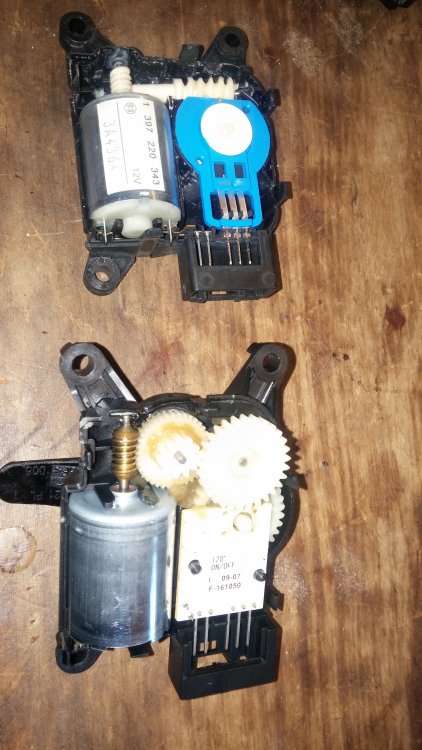777:
I must specify that I haven't road tested the car at this point, but in the case of the actuator attached to the white plastic rod, I removed it and discovered it was jammed at one end of its travel, so I pried the case apart with a couple of fine screw drivers. While newer models I saw on eBay seemed to have the two halves of the case fused together, mine opened up like a lunch box, revealing contents in good condition. Because of the triple-reduction worm gears I couldn't wiggle anything, so I popped the gears out and played with a tiny 12V battery and fine telephone wires, laying the bare contacts along the two poles attached to the end of the motor. This worked, so I added a couple of dabs of white grease to the gears and sent motor power along to the complex part at the other end whose gears also appeared to be intact.
Reversed polarity moved the arm back, so it seemed that the mystery part would still function. Of course the touches of 12V were very brief, as the travel of the actuator is short, so I simply turned over my pair of wires to reverse the motor to complete each cycle. After I had played with the thing enough to get the grease worked around the gears, I popped the top half of the case back on and put it back on the car.
When I turned on the key and experimented with heater buttons, the "recirculate" and "fresh-air" buttons caused the device to open and close the flap by alternately pushing and pulling on the rod.
My harassment of the other actuator more properly falls into the burnt-fingers-methodology classification. I could hear the thing trying to cycle, but I could only see the top of its white arm, or lever, or whatever one calls it. Let's use arm for now. It appeared to be stuck, with a wire or spring over the top of it. I could just see one end, so I grabbed the scope and started probing, seeing if I could get a better idea of how it worked. Wary of short circuits, I attempted to put tension on the spring with the lens of the scope, but opted for a forked green twig about ten inches long. It moved the spring around in a satisfying manner, and it eventually settled in what looked like an appropriate slot from my perspective.
Further examination with the scope revealed a dark something connected to the white arm. At first I had thought the arm wasn't working because it had become disconnected from whatever it was supposed to push, but there was something dark and plastic moving around, enclosed by the white nylon. So I bumped into the assembly a couple of times with the scope. Didn't seem to hurt anything. I cycled the temperature selector from low to high. The assembly seemed to be moving both ways now, and began to complete cycles.
I cycled it to halfway, 16 degrees, and called it a day. I had unwisely taken the lower half of the dash off the driver's side and would need to re-assemble it before any further testing, so I did that and then called it a day.
After breakfast I'll take the Cayenne for a test drive and report further.
UPDATE
There is still no warm air in the driver's footwell. The mystery right actuator still clicks occasionally at mid-ranges. At HI and up to 16.5 it remains still. I guess I'll have to figure out how to remove and examine it. More fun to be had.
UPDATE II
Much fun had this afternoon in the removal of two of the screws which held the plate the right-side mixing actuator occupied.. Easily revived actuator, but re-installing it and its plate are beyond my current tool supply. Somewhere I saw a photo of offset 1/4" mini ratchets. Now I understand why they're essential for this job. I think I need a long, size 20 Torx screwdriver.
With the right side likely to function when reassembled, I must next look to the left and figure out which one is making the clicking sound and keeping all warm air from the driver's side.



.thumb.jpg.f15f34dfecc8d6b970d09c4752f7909e.jpg)